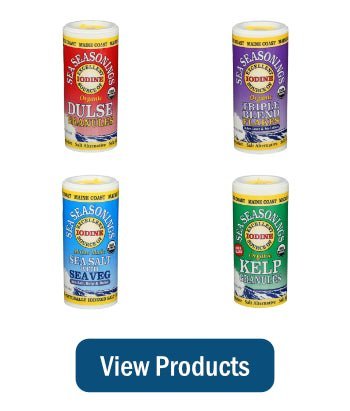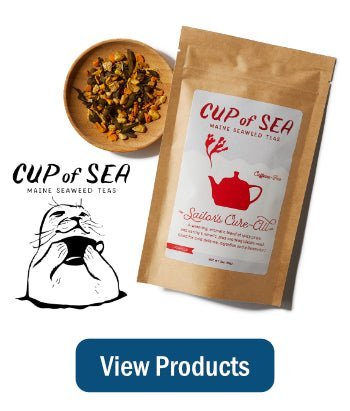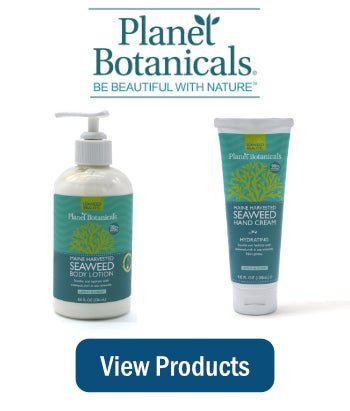Long-time customers with an eye for detail may notice that some of our sea vegetable nutritional information has changed, along with how it’s presented on the “Nutrition Facts” panel and on our website. In large part, this is because the FDA recently updated the Nutrition Facts panel required on most food packaging. These changes are a work in progress and if the information on our packaging doesn't quite match the website, give it time...we're still catching up!
Naturally, changes may raise questions. Customers might wonder, for example, why the dulse flakes they recently purchased contain less iron than the same flakes from 2 or 3 years ago. Is the dulse different? Or they may ask why iodine levels have changed. Or why we now report some nutrients on the label but not others that were reported in the past. More broadly, how are seaweed nutrition facts determined in the first place? Are there any rules governing nutritional labeling of seaweed?
The rules and practices behind food nutritional labeling in general can be complicated, and this is certainly no less the case for seaweed! If you’re interested, though, read on to learn how the special properties of sea vegetables affect how food labeling practices are applied to them on the new Nutrition Facts panel.

Nutrition Facts panel for whole leaf kelp
1: Sea vegetables have unique nutritional profiles
Like many other whole, natural foods, sea vegetables as a group share certain nutritional characteristics, no matter what species they are. All sea vegetables are good sources of dietary fiber, minerals, and iodine. On the other hand, we shouldn’t expect to get vitamin D from seaweed unless it’s been deliberately added. As with most plant-based foods, seaweed doesn’t contain vitamin D. Nor do we need to worry about fat or sugar…seaweed is low in both.
However, this doesn’t mean all sea vegetables are the same when it comes to nutrition. Each species has its own distinct nutritional profile. For example, although dulse and laver are related as red seaweeds, laver typically contains twice as much protein as dulse, while dulse typically contains 2 to 3 times more potassium than laver. These differences likely have a genetic basis, because they generally hold true no matter where or when the dulse or laver is harvested. In similar fashion, although carrots are related to parsnips, carrots are rich in vitamin A but parsnips contain practically none, while parsnips typically contain much more folate than carrots.
2: Sea vegetables get nutrients from the ocean
As with plants, some of the nutrients found in seaweed, such as carbohydrates and certain vitamins, are a product of photosynthesis and cellular metabolism. However, sea vegetables differ from most other plant-based foods in that they obtain mineral and elemental nutrients from seawater, not from the soil. Even though most seaweeds grow attached to the ocean floor with holdfasts that superficially resemble roots, they don’t absorb minerals or elements from the rock or “soil” where they grow. Instead, they absorb them from the ever-moving sea.
The ocean is constantly circulating with waves, tides and currents. This means that sea vegetables, unlike land plants, won’t deplete a limited local supply of minerals and elements as they grow. Seaweed suppliers can confidently state their products are high in certain minerals no matter where in the ocean they’ve been grown.
Also, seawater composition includes every mineral or element known to be important for human health, as well as trace levels of many others. These minerals and elements are dissolved in all the world’s oceans, though concentrations can vary somewhat depending on depth, currents, temperature, and other factors. Seaweed has an amazing capacity to absorb and bioaccumulate the elements and minerals found in seawater, which is why it’s regarded as such a good source of minerals. For example, iodine, an essential human nutrient, is naturally present in all the world’s oceans at about 0.065 parts per million (ppm). Some seaweed species can bioaccumulate iodine to 3,000 ppm or more!
Soil, on the other hand, can be deficient in various minerals and elements. Although farmers can make up for these deficiencies with good soil management and by adding compost or fertilizer, most large farming operations fertilize primarily for crop growth, not human nutrition. This means they use relatively simple fertilizers consisting of nitrogen, phosphorous, and potash. Trace minerals are rarely included in most commercial fertilizers.

Wild kelp bed
3: Sea Vegetables haven’t been domesticated very long
Unlike the vast majority of other plant and animal species humans rely upon for food, sea vegetables have a very short history of domestication. While some species, such as nori, have been farmed for a few hundred years, during most of that time seaweed farming relied upon wild natural seed set. Little to no selective breeding has been done to standardize traits and nutritional content within the most widely consumed seaweed species. This means seaweed can have a more variable nutrient content than crops that have been domesticated for many hundreds, if not thousands, of years. This inherent variability can be even more pronounced in our wild harvested sea vegetables!

Farmed kelp line
4: There’s not a lot of standardized data for seaweed nutritional composition
Over the past century or so, scientists have analyzed a wide variety of crops, animals (chicken, beef, seafood, etc.), and commercially available foods for nutritional profiles. This information has been compiled into datasets that nutritionists, food companies, and even the general public can access to determine the typical nutrient profiles of foods. The US Department of Agriculture (USDA) maintains one of the most comprehensive and widely used datasets, accessed at their FoodData Central website. The website has a search tool for users to view the nutritional profiles of a wide variety of foods. The FDA provides similar information in a simplified format for raw fruits, vegetables, and fish. Nutritional information found on internet sites and on many food labels often comes from these or similar datasets.
Unfortunately, these datasets offer only very limited information for seaweed products. The USDA FoodData Central website, for example, offers only 10 results in the “Legacy Foods” category and none are for seaweed in its raw, dried form.
There are a few reasons why nutritional information for dried seaweed is so lacking in standardized datasets. Up until fairly recently, few people in the US and other western countries even ate sea vegetables, so there wasn’t a lot of incentive to investigate and publish their nutritional profiles. This unfamiliarity also led many people, including some scientists, to view all seaweeds as a generic entity, lumped together as ‘kelp’. In addition, older analytical methods used for other foods haven’t always been appropriate for seaweed. Finally, seaweed’s inherent variability, discussed in points 1-3, can make it challenging to derive standard values for some seaweed nutrients.
The lack of a standardized dataset for seaweed nutrients means producers must get their nutritional information from other sources. These sources may include their own testing, scientific literature, or simply another company’s information (while trusting it’s accurate!). Since it would be prohibitively expensive to test every single batch of seaweed as it comes in from the harvest grounds, the approach used by Maine Coast Sea Vegetables is to calculate a composite average for each nutrient from our own testing and the most recent scientific literature. This means the nutrient values on the label and website will probably not precisely match what is actually in the product. Instead, they reflect what the product contains on average when it’s harvested throughout the season from multiple locations.
5: Sea vegetables fall under the same nutritional labeling rules as other foods
Just because our sea vegetables are a wild, whole food harvested from the ocean doesn’t mean they’re exempt from rules applying to other foods. The rules and regulations around things such as food safety, labeling, and Nutrition Facts apply to seaweed products just as they do to any other food. Navigating this regulatory landscape can be daunting, but fortunately, when it comes to the Nutrition Facts panel there are just a few important things for customers to know.
The requirement to include a Nutrition Facts panel on food packaging comes from the Nutrition Labeling and Education Act (NLEA), passed by the US Congress in 1990. The idea was to help consumers make better, more educated choices and to motivate companies to produce healthier food. The iconic black and white Nutrition Facts panel first began appearing on almost all packaged foods in 1994. The Facts must declare the ‘usual’ serving size and the amount per serving of calories, sodium, protein, fat, saturated fat, cholesterol, carbohydrates, sugar, fiber, and certain vitamins and minerals.
6: The rules sometimes change!
Nutritional labeling rules and other rules affecting how foods are packaged and sold occasionally get updated based on new information, science, and health priorities. The most recent changes to the Nutrition Facts panel occurred in 2016 and began rolling out in January 2020. The new Nutrition Facts panel looks much the same as the old one, but a closer examination reveals some important changes.
Serving Size
Nutrition Facts serving sizes are required by law to be based on the amount of a food or beverage that people typically consume each time. These amounts are known as the Reference Amounts Customarily Consumed (RACC), and FDA guidance establishes RACC’s for a great many commonly eaten foods, including seaweed. The FDA updated the RACCs for the first time since 1993 for the 2016 updated Nutrition Facts panel, though seaweed remains the same at a 5-gram serving for any dried form and 3 grams for sheets.
There are two important considerations when it comes to serving size. The first is that the RACCs recommended by the FDA are non-binding. Food manufacturers can go with a different serving size if they feel it’s appropriate. We know from customer feedback and our own experience that people usually eat small servings of seaweed as a powder, granule, or some other milled variety, but they eat larger servings when it is in whole leaf form. This is why our serving size for milled seaweed products is less than 3 grams, but for whole leaf it’s 5-7 grams.
The second consideration is that even though the nutrient levels given on the Nutrition Facts panel are based on serving size, the serving size itself is based on what the typical person eats, not on what they are supposed to eat. Serving sizes are not recommendations or advice, and everyone is free to eat as little or as much as they desire.
Added Sugar
This was perhaps one of the most talked about changes to the new Nutrition Facts panel, which is why we mention it here even though it doesn’t usually pertain to raw dried seaweed. Many processed foods today have sugar added to them, considered a major cause of American’s rising rates of obesity and diabetes. By including added sugars, the FDA hopes to give people information to make better choices.
Sea vegetables, of course, contain practically no natural sugars to start with and the only product we sell with added sugar is our delicious Kelp Krunch™. It’s OK to treat yourself now and then, especially if you get healthy sea vegetable nutrition at the same time!
Required Vitamins and Minerals
The vitamins and minerals required on the original Nutrition Facts panel in 1993 were vitamins A and C and the minerals calcium and iron. At the time it was believed Americans were most likely to be deficient in these specific vitamins and minerals.
Priorities changed with the 2016 update. Calcium and iron are still important, but vitamins A and C have been replaced by potassium and vitamin D. Vitamin D helps the body absorb calcium for strong bones, and potassium helps lower blood pressure, especially for those with high blood pressure. Vitamins A and C, on the other hand, are abundant in many other foods and most American’s aren’t likely to be deficient.
In addition to reporting these required vitamins and minerals, food manufacturers can also voluntarily report other vitamins and minerals. Since seaweed contains so many, we pick and choose the ones we feel are important to our customers and where we feel we have the most reliable information. The FDA requires that the reported levels for any nutrient be supported by science. Furthermore, they have to occur at certain minimum levels in a serving in order to be reported, and the numbers themselves are subject to FDA ‘rounding rules.’
Rounding Rules
Rounding is when a numerical value is presented as some upper or lower value based on a rule, for example rounded to the nearest whole number, nearest 5, or nearest 10. The FDA bases nutrient rounding rules on the size of the recommended daily value (DV) for that nutrient. Potassium has a large DV of 4,700 mg, so the FDA recommends rounding potassium to the nearest 10mg or reporting it as 0mg or as “not a significant source” if the level is less than 94mg (<2% DV) per serving. Iron, on the other hand, has a small DV of 18mg, so the FDA recommends rounding it to the nearest 0.1mg or reporting it as 0mg or “not a significant source” if the level is less than 0.4mg (<2% DV) per serving. This is why you might not see certain nutrients in seaweed at small servings, only to see them magically appear at a larger serving. They were there all along, but not at levels considered significant by the FDA.
For the most part we try to follow FDA rounding rules on our sea vegetable Nutrition Facts panels. However, if you go to our website, you can find a table of sea vegetable nutritional information per 100 grams. In this table, nutrient values are not rounded per FDA rounding rules, so they more closely reflect the average level determined from our research. This table is useful for comparing nutrient levels between sea vegetables without having to account for serving size. However, customers who enjoy math will notice that when they extrapolate nutrient levels from our Nutrition Panels to amounts per 100 grams (or vice versa), the numbers won’t always match. Now you know this is because we round the values on the Nutrition Facts Panel but not on our website tables!
Percent Daily Value Updates
The percent daily value listed for each nutrient on the Nutrition Facts panel tells you how much of your daily requirement for that nutrient is in each serving. Many of these values were changed with the 2016 update, based on more recent science. The DV for calcium was originally 1,000 mg; the updated value is 1,300mg. Magnesium has been increased by 20mg from 400mg per day to 420mg per day. The DV for potassium was increased by more than 30%, from 3,500mg to 4,700mg.
What this tells us is that nutrition science evolves with new and hopefully better science. This, along with more recent testing information, helps explain why the Nutrition Facts panel on a dulse package from 2019 doesn’t match the Nutrition Facts panel on dulse sold in 2021. Fortunately, some things never change. Sea vegetables provided essential minerals and other nutrients in 1993 and they still do today in 2021!
7: Sea vegetable health and nutrition claims must be supported by science
An important NLEA requirement is that it strictly defines when and how manufacturers can make nutrient claims such as “low fat”, “good source”, “high in”, “healthy”, or other claims. In general, this is based on the 5/20 rule; if something is present at 5% or less of the DV it’s considered low and if it’s present at 20% or more of the DV it’s considered high. In order to make a nutrient claim, it must be present in a serving at certain minimum levels; the claim has to be supported by science; the manufacturer has to declare the level of the nutrient on the Nutrition Facts panel; and the manufacturer must be able to show through testing or an accepted database that the nutrient really is present at the declared value.
NLEA nutrient claim rules are important for sea vegetables because they discourage manufacturers from making false, misleading, or exaggerated health claims for their products. Not only are manufacturers not allowed to make unsupported claims on their packaging, they are also not allowed to make such claims in any written or promotional materials. We at Maine Coast Sea Vegetables have long taken pride in supporting our customers based only on reliable information…in fact, this is written into our mission statement! This is why we take a conservative approach when we tout the many health and nutritional benefits of sea vegetables. We believe most other seaweed companies try to do the same, but beware of exaggerated health claims for sea vegetables that seem too good to be true.
To sum it all up… We at MCSV are committed to supporting customers with reliable information, including on nutrition. This means that as science advances or as regulations change, the information we provide might also change. However, you can always count on sea vegetables to deliver healthy nutrition and added flavor to everyday meals!







